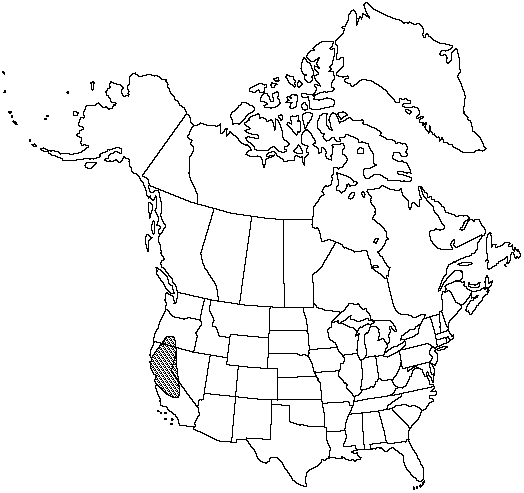Difference between revisions of "Cheilanthes intertexta"
in Abrams, Ill. Fl. Pacific States 1: 28. 1923.
FNA>Volume Importer |
imported>Volume Importer |
||
| (2 intermediate revisions by 2 users not shown) | |||
| Line 1: | Line 1: | ||
{{Treatment/ID | {{Treatment/ID | ||
|accepted_name=Cheilanthes intertexta | |accepted_name=Cheilanthes intertexta | ||
| − | |accepted_authority=(Maxon) Maxon | + | |accepted_authority=(Maxon) Maxon |
|publications={{Treatment/Publication | |publications={{Treatment/Publication | ||
| − | |title=in Abrams,Ill. Fl. Pacific States | + | |title=in Abrams, Ill. Fl. Pacific States |
|place=1: 28. 1923 | |place=1: 28. 1923 | ||
|year=1923 | |year=1923 | ||
}} | }} | ||
|common_names=Coastal lip fern | |common_names=Coastal lip fern | ||
| + | |special_status={{Treatment/ID/Special_status | ||
| + | |code=E | ||
| + | |label=Endemic | ||
| + | }} | ||
|basionyms={{Treatment/ID/Basionym | |basionyms={{Treatment/ID/Basionym | ||
|name=Cheilanthes covillei subsp. intertexta | |name=Cheilanthes covillei subsp. intertexta | ||
| Line 39: | Line 43: | ||
-->{{#Taxon: | -->{{#Taxon: | ||
name=Cheilanthes intertexta | name=Cheilanthes intertexta | ||
| − | |authority=(Maxon) Maxon | + | |authority=(Maxon) Maxon |
|rank=species | |rank=species | ||
|parent rank=genus | |parent rank=genus | ||
| Line 50: | Line 54: | ||
|distribution=Calif.;Nev.;Oreg. | |distribution=Calif.;Nev.;Oreg. | ||
|reference=None | |reference=None | ||
| − | |publication title=in Abrams,Ill. Fl. Pacific States | + | |publication title=in Abrams, Ill. Fl. Pacific States |
|publication year=1923 | |publication year=1923 | ||
| − | |special status= | + | |special status=Endemic |
| − | |source xml=https:// | + | |source xml=https://bitbucket.org/aafc-mbb/fna-data-curation/src/2e0870ddd59836b60bcf96646a41e87ea5a5943a/coarse_grained_fna_xml/V2/V2_758.xml |
|genus=Cheilanthes | |genus=Cheilanthes | ||
|species=Cheilanthes intertexta | |species=Cheilanthes intertexta | ||
Latest revision as of 20:25, 5 November 2020
Stems short-creeping, usually 3–7 mm diam.; scales usually bicolored, with broad, well-defined, dark, central stripe and narrow, light brown margins, linear-lanceolate, straight to slightly contorted, strongly appressed, persistent. Leaves clustered, 4–25 cm; vernation noncircinate. Petiole dark brown, rounded adaxially. Blade lanceolate to ovate-deltate, usually 3-pinnate at base, 1–4 cm wide; rachis rounded adaxially, with scattered scales and sparse monomorphic pubescence. Pinnae not articulate, dark color of stalk continuing into pinna base, basal pair not conspicuously larger than adjacent pair, usually equilateral, appearing glabrous to sparsely pubescent adaxially. Costae green adaxially for most of length; abaxial scales multiseriate, ovate-lanceolate, deeply cordate at base, with overlapping basal lobes, conspicuous, the longest 0.4–1 mm wide, imbricate, often concealing ultimate segments, long-ciliate, cilia usually confined to proximal 1/2. Ultimate segments oblong to ovate, beadlike, the largest 1–3 mm, abaxially densely covered with branched hairs and small, ciliate scales, adaxially with scattered branched hairs or glabrescent. False indusia marginal, weakly differentiated, 0.05–0.25 mm wide. Sori ± continuous around segment margins. Sporangia containing 64 spores.
Phenology: Sporulating late spring–fall.
Habitat: Rocky slopes and ledges, usually on igneous substrates
Elevation: 500–2800 m
Distribution

Calif., Nev., Oreg.
Discussion
Preliminary isozyme analyses support D. B. Lellinger's (1985) suggestion that Cheilanthes intertexta is a fertile allotetraploid hybrid between C. gracillima and C. covillei. It is morphologically most similar to the latter parent (see comments under C. covillei), but it is occasionally confused with C. gracillima, with which it apparently hybridizes to form sterile intermediates that have been called C. gracillima var. aberrans M. E. Jones. Cheilanthes intertexta may also be confused with C. clevelandii, with which it is partially sympatric. In addition to the characters given in the key, C. intertexta is distinguished from closely related sexual species by having larger spores averaging more than 55 µm in diameter.
Selected References
None.